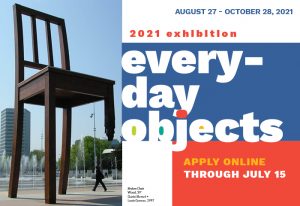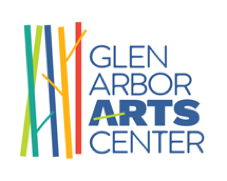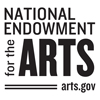 NOTE TO APPLICANTS: The GAAC will offer an on-line version of Everyday Objects that will be viewable on the GAAC website. A traditional, in-gallery version of the exhibition will be designed in response to State of Michigan COVID-19 operating guidelines.
NOTE TO APPLICANTS: The GAAC will offer an on-line version of Everyday Objects that will be viewable on the GAAC website. A traditional, in-gallery version of the exhibition will be designed in response to State of Michigan COVID-19 operating guidelines.
Glen Arbor Arts Center [GAAC]
August 27 – October 28, 2021
On-line application period: through July 15, 2021 at midnight.
Western art before the 20th Century, primarily still life paintings, is filled with everyday objects. But in the 20th Century, things shifted. The Glen Arbor Arts Center’s exhibition Everyday Objects explores this territory.
What happens when an artist gets her hands on a common object, and begins to reimagine it? In the process of transformation, the object may still look like the thing, but its functional purpose is no longer its prime reason for being. For example: Marcel Duchamp’s Fountain [a porcelain urinal], and Meret Oppenheim’s Object [a fur-lined teacup] challenged traditional understandings. These 20th Century works are now embedded in the art historical canon because the artists transformed these everyday objects physically and contextually, and estranged them from their originally-intended function.
Everyday Objects seeks works in which common materials and objects are the basis for new, inventive compositions:
- What happens when the artist alters/adjusts/twists an object’s commonly understood physical appearance?
- What happens when the artist takes an everyday object and manipulates its agreed-upon meaning?
- If commonly regarded as a “functional” object, how might the artist move beyond function?
- Or, incorporate function into a new compositional idea?
- What happens when everyday objects are used as art-making materials + components?
- How does the artist take an everyday object and make it go from ordinary to extraordinary?
What are the aesthetic possibilities in mundane objects? Or, in the words of the late Hungarian-born visual artist Sari Dienes, “Bones, lint, Styrofoam, banana skins, the squishes and squashes found on the street: nothing is so humble that it cannot be made into art.”
Looking For
Visual art in 2D + 3D. Work must be made by the applicant between 2019 and 2021.
Open To
2D and 3D work, including clay, collage, drawing, fiber, furniture, metal, mixed media, painting, photography, sculpture, wood.
Size Restrictions
2D work should not exceed 48” in width or 65” in length.
3D work must be freestanding and easily moved, not to exceed 35 pounds. Because of companion programs planned in conjunction with the exhibition, 3D work will be occasionally and temporarily relocated in the gallery and in the GAAC.
Application Fee
Applicants may enter up to two [2] submissions for the juror’s consideration. $25 GAAC member, $35 nonmember. This is a nonrefundable fee.
Everyday Objects calendar
- Exhibitions Dates: August 27 – October 28, 2021
- Application on-line: April 15 – July 15, 2021 at midnight
- Report Jury Results: Late July 2021
- Artwork drop-off: Friday, August 20; Saturday, August 21, 9 am – 2 pm both days.
- Shipping drop-off: August 16 – 19, 2021
- Artwork pick-up: Friday, October 29; and Saturday, October 30, 9 am – 2 pm each day.
Juror
Len Cowgill is a visual artist and manager of the Tamarack Gallery in Omena, Michigan. About himself he wrote: “All writing comes from art; all art is communication. I find that, unlike most careers, being an artist involves not just the solving of problems, but the creation of problems you then try to solve. When I was a kid I wanted to be an illustrator because I loved the variety of images on magazine covers and books and movie posters. But after college I realized I wanted to be more in control of my images, I wanted complete freedom. Later, I began using found objects in my work, old handmade things that helped me move away from two dimensional works in frames. Joseph Cornell was a great influence. I began to put my drawings in printers’ trays and boxes and bottles and wooden drawers and old suitcases, things that have their own past and weight, and doing this made every drawing more grounded. The drawings and their titles now suggested stories, open-ended stories that allow the viewer to visualize their own tale, to add something of their own to what I started.”
https://www.watsonmacraegallery.com/len-cowgill
http://www.tamarackartgallery.com/artists/?/category-74
Awards
Three awards will be given: $300 Best of Show award made possible by the Amy L. Clark-Carels Family Fund; and two, $100 Merit Awards.
Submission Criteria
- Applicants must attach high-quality digital images of their entry on the on-line application. See the on-line application for file size instructions. If your work is framed and/or under glass, please photograph the artwork without its frame and without glass. Photograph the artwork only.
- 2D work [e.g. painting, drawing, photography, printmaking, collage, fiber, mixed media] should not exceed 48” in width, or 65” in height.
- Work intended to be exhibited on the gallery walls must be gallery-ready to hang when it is delivered. For hanging: Use gallery wire. Entries with saw tooth hanging hardware will not be accepted.
- No wet paintings, or warped canvases will be accepted.
- 2D work is not required to be framed [e.g. work executed on gallery-wrapped canvases or mounted on cradled wood panels]; but this work is required to be gallery-ready to hang [see above hanging requirements]. If left unframed, the work’s edges must be tidy and finished.
- 3D work must be freestanding and easily moved by one person. Weight should not exceed 35 lbs.
- Work should have been made by the applicant between 2019 and 2021.
- No work will be accepted after the dates and times for delivery listed on the prospectus.
- The artist’s contact email provided on the application must remain active during the submissions and exhibition process. Applicants are responsible for checking their email for exhibition acceptance and/or decline, and other information regarding the exhibition.
Artist’s Statement
Applicants selected to exhibit work in Everyday Objects will be asked to submit a short [100 words max] artist’s statement that provides viewers with some context for looking at the artwork.
Return of Accepted Work
Work accepted for exhibition in Everyday Objects must be accompanied by a pre-paid return shipping label if the exhibitor is unable to reclaim his/her work at the end of the exhibition. If this work sells during the exhibition, the expense of the pre-paid return shipping label will be borne by the exhibitor.
Sales
The sale price written on the application is the FINAL price if the work is accepted for exhibition. Exhibitors may not change sale price after the work is accepted for exhibition. The GAAC will retain a 40% commission on work sold during the exhibition. Artists receive 60% of the final selling price. Artists will receive payment following the close of the exhibition.
NOTE: The GAAC staff and Exhibitions Committee reserve the right to the final selection of work to be shown in the exhibition. Accepted work may not be removed before the close of the exhibition.
For More Information
Contact Sarah Bearup-Neal, GAAC Gallery Manager: 231-334-6112.








